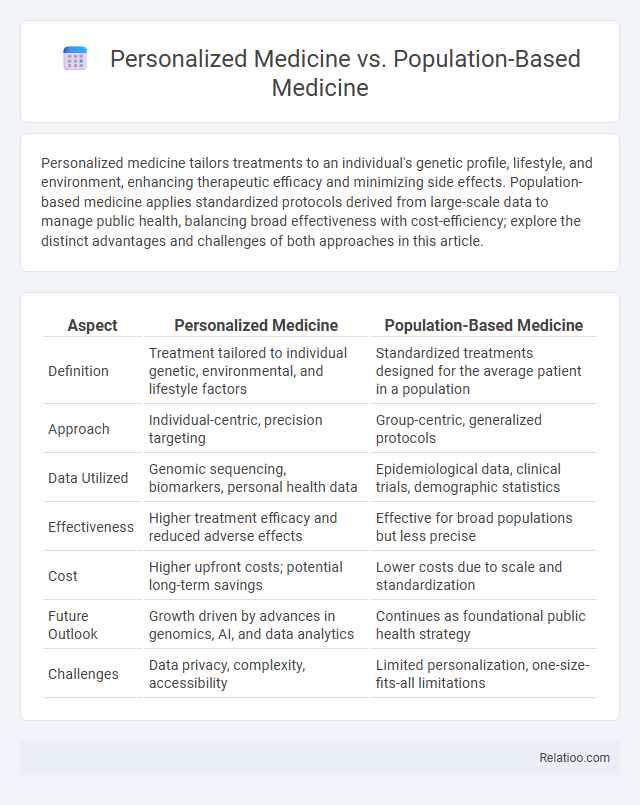Personalized medicine tailors treatments to an individual's genetic profile, lifestyle, and environment, enhancing therapeutic efficacy and minimizing side effects. Population-based medicine applies standardized protocols derived from large-scale data to manage public health, balancing broad effectiveness with cost-efficiency; explore the distinct advantages and challenges of both approaches in this article.
Table of Comparison
| Aspect | Personalized Medicine | Population-Based Medicine |
|---|---|---|
| Definition | Treatment tailored to individual genetic, environmental, and lifestyle factors | Standardized treatments designed for the average patient in a population |
| Approach | Individual-centric, precision targeting | Group-centric, generalized protocols |
| Data Utilized | Genomic sequencing, biomarkers, personal health data | Epidemiological data, clinical trials, demographic statistics |
| Effectiveness | Higher treatment efficacy and reduced adverse effects | Effective for broad populations but less precise |
| Cost | Higher upfront costs; potential long-term savings | Lower costs due to scale and standardization |
| Future Outlook | Growth driven by advances in genomics, AI, and data analytics | Continues as foundational public health strategy |
| Challenges | Data privacy, complexity, accessibility | Limited personalization, one-size-fits-all limitations |
Introduction to Personalized and Population-Based Medicine
Personalized medicine tailors medical treatment to Your genetic profile, lifestyle, and environment, enhancing therapeutic accuracy and efficacy. Population-based medicine focuses on health strategies targeting groups, utilizing epidemiological data to prevent disease and improve outcomes at scale. Understanding the fundamental differences between these approaches is essential for optimizing health planning and resource allocation.
Definition and Core Principles
Personalized medicine tailors medical treatment to individual genetic, environmental, and lifestyle factors, emphasizing precision and individualized care. Population-based medicine focuses on health outcomes of groups, prioritizing prevention and intervention strategies based on epidemiological data. Health planning involves the systematic organization of healthcare resources and policies to improve population health outcomes through coordinated efforts and resource allocation.
Historical Evolution of Medical Approaches
Personalized medicine has evolved from the traditional population-based medicine, shifting from a one-size-fits-all approach to tailored treatments based on genetic, environmental, and lifestyle factors. Population-based medicine historically prioritized large-scale public health strategies to control epidemics and improve community health outcomes. Health planning has progressed by integrating these approaches, enabling your healthcare to become more precise while maintaining effective population health management.
Key Technologies Driving Personalized Medicine
Key technologies driving personalized medicine include genomic sequencing, bioinformatics, and advanced biomarker identification, enabling precise diagnosis and tailored therapies based on individual genetic profiles. Population-based medicine relies on epidemiological data and statistical models to develop generalized treatment standards, while health planning utilizes big data analytics and predictive modeling to allocate resources effectively across communities. Integration of artificial intelligence and machine learning accelerates personalized treatment development, distinguishing it from traditional population-wide approaches and enhancing healthcare outcomes.
Advantages of Population-Based Medicine
Population-based medicine offers the advantage of improving public health outcomes by targeting entire communities with preventive measures, vaccinations, and screening programs, leading to reduced incidence of diseases on a large scale. This approach enables efficient allocation of healthcare resources and cost-effective interventions, benefiting the overall population's well-being. Public health policies and health planning based on population data support equitable access and address social determinants of health, which personalized medicine alone may not fully achieve.
Challenges and Limitations of Personalization
Personalized medicine faces significant challenges including high costs, complexity in genetic data interpretation, and limited accessibility, which hinder its widespread implementation compared to population-based medicine that focuses on generalized treatment protocols. The lack of standardized methodologies and ethical concerns related to patient data privacy further complicate personalized approaches. Health planning struggles to integrate personalized medicine due to resource allocation issues and the need for scalable solutions that balance individual patient needs with public health objectives.
Cost Implications and Accessibility
Personalized medicine tailors treatments to individual genetic profiles, often resulting in higher upfront costs but improved efficacy and reduced long-term expenses due to targeted therapies. Population-based medicine emphasizes standardized treatments and preventive strategies, which lowers per capita costs but may overlook individual variability, potentially affecting overall outcomes. Health planning integrates both approaches to optimize resource allocation, balancing cost efficiency and accessibility while striving to maximize healthcare quality across diverse populations.
Ethical Considerations and Patient Privacy
Personalized medicine tailors treatment to individual genetic profiles, raising ethical concerns regarding data security and informed consent to protect patient privacy. Population-based medicine emphasizes broad public health interventions, which can lead to ethical dilemmas over resource allocation and maintaining anonymity in large-scale data collection. Health planning requires balancing equitable access to care with safeguarding sensitive health information, ensuring policies comply with ethical standards and protect patient confidentiality.
Future Trends in Medical Care
Future trends in medical care emphasize personalized medicine, leveraging genomics and AI to tailor treatments to individual patients' genetic profiles, lifestyle, and environmental factors. Population-based medicine continues evolving through big data analytics and predictive modeling to identify risk patterns and improve public health strategies on a large scale. Health planning integrates these advancements by using digital health infrastructure and real-time data to optimize resource allocation, enhance preventive care, and support dynamic policy-making for sustainable healthcare systems.
Integrating Personalized and Population-Based Strategies
Integrating personalized medicine with population-based medicine enhances health planning by combining individual genetic, environmental, and lifestyle data with broader epidemiological trends to optimize healthcare outcomes. Your treatment plans benefit from this dual approach as personalized interventions target specific patient needs while population-based strategies address public health concerns and resource allocation. Balancing these methods supports more effective disease prevention, early detection, and tailored therapies, ultimately improving overall healthcare system efficiency.

Infographic: Personalized Medicine vs Population-Based Medicine
 relatioo.com
relatioo.com